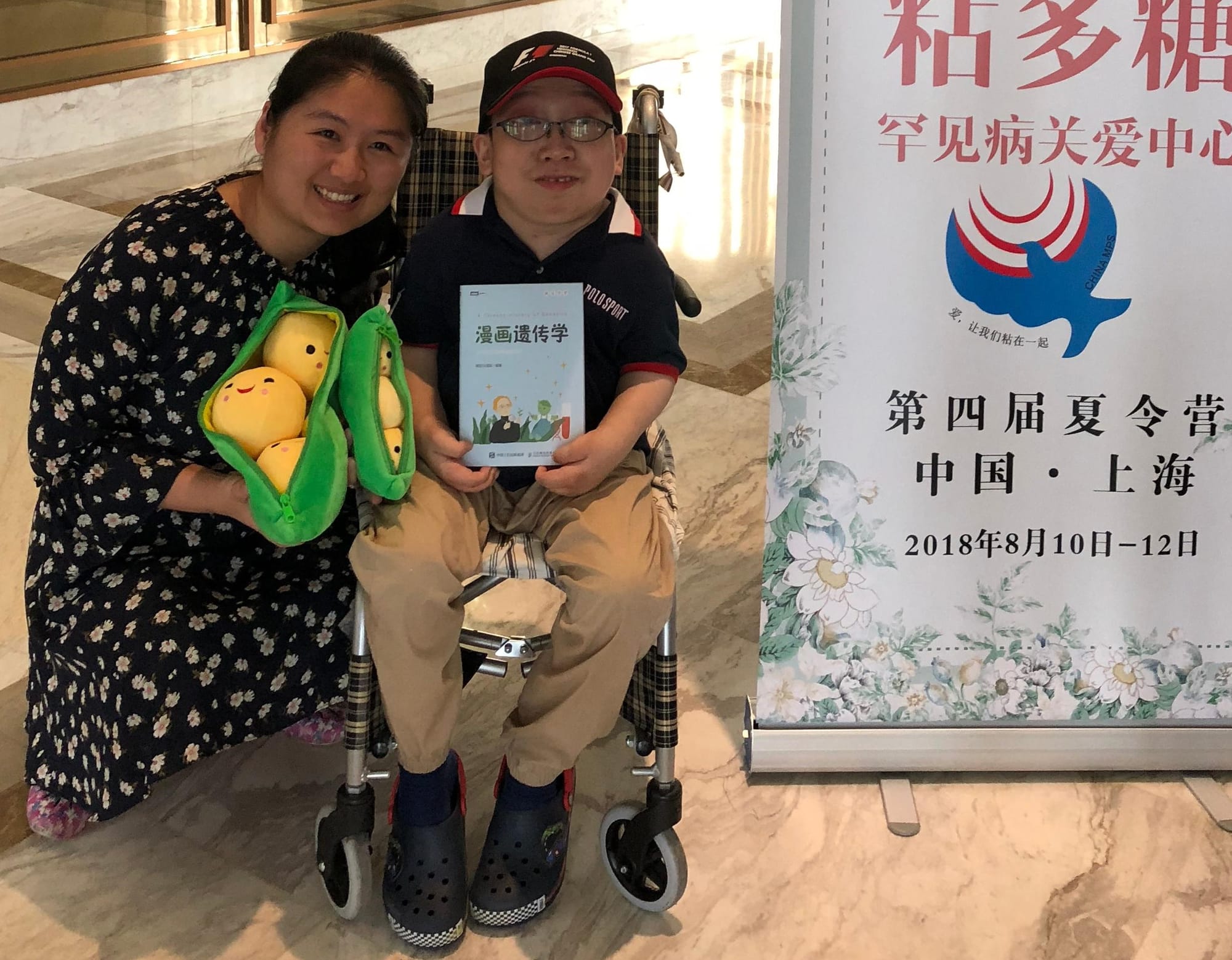Wonder Sir Founder Chen Yiwei on China’s Rare Disease Definition and Recent Policy Boost for Foreign CGT Investment

Motivated by a profound sense of purpose and deeply moved by the suffering of Chinese rare disease patients, Chen Yiwei, a seasoned researcher in genetics and gene therapy with education in Germany, made a bold move in 2016. She departed from her comfortable pharmaceutical R&D position to launch Wonder Sir, an influential platform in China for popularizing genetics and rare disease science. As she fulfills her mission to “make the rare seen,” Chen Yiwei has gained a unique perspective on China’s rare disease ecosystem, distinct from Western markets. This is the first part of our conversation.

Wonder Sir Founder Chen Yiwei with an MPS Patient 2018
China's Rare Disease Definition
Kelly: Why does China adopt a catalog-based approach to define rare diseases? What are its advantages, and what are the limitations?
Chen Yiwei: When we look at the definitions of rare diseases in other countries/regions, no two countries/regions are exactly the same. Typically, we use the number of affected individuals. For instance, any disease with fewer than 200,000 patients is considered rare in the US. Or it's based on prevalence. For example, in Taiwan, the prevalence is less than one in ten thousand, and in the European Union, it's less than two in a thousand. It's mainly based on epidemiological criteria; if a disease falls within that range, it's classified as rare; if it's outside the range, it's excluded. The advantage is that it clearly defines "rarity."
But it requires a premise - I need to understand the epidemiological data for each disease to judge whether it falls within that category. However, in our country [China], most of these data are based on conditions considered rare abroad, and their epidemiological data are relatively scarce domestically. So, if we adopt a similar approach to other countries and regions, we would be caught in a 'chicken or egg' dilemma.
In 2010, Shanghai introduced the first local standard for rare diseases with a very strict criterion. If a disease's prevalence was less than one in five hundred thousand, it would be classified as rare. This standard was much more restrictive than most countries, as the range in most countries is between 5 to 76 patients or fewer per 100,000 individuals in the general population.
So, [Shanghai's] definition wasn't widely adopted, especially by [orphan drug] companies, as [based on this definition], their drugs might no longer be considered "rare." So, this [prevalence and incidence-based] approach was attempted locally in China, but it wasn't very successful.
Then, in May 2018, the first batch of the rare diseases catalog was released. It was innovative because [it attempted to] define a list when we lack epidemiological data. So, they [the National Health Commission (NHC)] started with a catalog and indicated it would be dynamically updated.
[The NHC] also defined a set of inclusion criteria for the catalog. These include (1) diseases with lower prevalence or incidence rates domestically and internationally, (2) coupled with significant harm to patients and families, which indicates a higher degree of severity, and (3) if it could be diagnosed and treated by available interventions – even if those methods were still in development.
As a result of this release, China has put rare diseases on the map since 2018. It [in itself] is a breakthrough.
Of course, there are also disadvantages and opportunities for improvement. One is the limited coverage. The first batch was relatively small, with just 121 entries, far fewer than the generally known six to seven thousand rare diseases.
Additionally, some of the entries correspond to diseases in a non-unified way globally. For instance, some entries represent a broader category, like entry 98, 'progressive muscular dystrophies' - a large category with various diseases and subtypes nested within. In contrast, other entries are for subtypes under a condition, like entry 35, which lists only types 1 and 2 of glycogen storage disease, ignoring the rest.
If it were broken down by genes relevant to many hereditary diseases, it would be around 300 entries, more than the 121 in the list. [Yet similarly], sometimes, it counts as one gene per entry, and sometimes, multiple genes are counted as one entry. This inconsistency can lead to confusion impacting [downstream] resource allocation.
Another area needing further refinement is the inclusion criteria for the catalog. For instance, the first criterion is about low incidence and prevalence. But how low is considered low? The second criterion is about severity. What is considered 'severe'? We need more quantifiable measures.
These challenges may be why adjustments to the first edition are complex and why it hasn't been updated since its release.
China's New Policy for Foreign CGT Investment
Kelly: The State Council recently issued the 'Opinions on Further Optimizing the Foreign Investment Environment and Increasing the Attractiveness of Foreign Investment.' It encourages foreign-invested enterprises to conduct clinical trials of cell and gene therapy drugs listed overseas and optimize regulatory approval procedures for drugs whose overseas production has been transferred to China. We know that in the previous 'Special Management Measures for Foreign Investment Access (Negative List)' issued by the National Development and Reform Commission and the Ministry of Commerce, there were explicit provisions: foreign investment in 'human stem cells, gene diagnosis and treatment technology development and application' is prohibited. What are your thoughts on this new development?
Chen Yiwei: Compared to the previous policy of the negative list, this should be favorable. It might be related to our country's current focus on promoting economic growth. And health is a priority development area.
Gene therapy and cell therapy are part of biotechnology, which is at the forefront of medical technology. In the past, China's focus was primarily on conventional pharmaceuticals. [As such], our current domestic capacity cannot meet patient demands. Then, allowing products already marketed abroad, which have proven their safety and effectiveness, could significantly enhance their accessibility within our country.
Additionally, if these therapies were tested domestically, patients who may not afford these treatments upon commercial launch could access a safe and effective option through participation in clinical trials, possibly saving lives.
Furthermore, suppose the clinical trial results demonstrate significant efficacy, safety, and the irreplaceable nature of these therapies; in that case, it might lead to some relaxation of medical insurance policies related to reimbursement of high-cost medications. If there are such relaxations, it would be a tremendous driving force for the entire biopharmaceutical field. So, overall, this is a very positive development.
About Chen Yiwei
Founder of the Genetic and Rare Disease Science Popularization Platform "豌豆Sir"
2022 Ginkgo Fellow
Distinguished Research Fellow at the CEIBS Research Center for Smart Healthcare
Council Member of the Shanghai Foundation for Rare Diseases
Secretary-General of the Academic Board of Orphan Drug, China Biomedical Industry Chain Innovation and Transformation Alliance
Graduated with a bachelor's degree from the Chinese University of Hong Kong, obtained master's and doctoral degrees from Heidelberg University in Germany, and has over ten years of experience in genetics and gene therapy research and development. In 2016, initiated the Genetic and Rare Disease Science Popularization Platform "豌豆Sir."
Currently serves as the founder of the Chinese Medical and Research Network of Lesch–Nyhan syndrome (LNS), council member of DEBRA China, member of the Academic Committee of the "Chinese Medical Case Repository," member of the Genetics and Reproductive Special Committee of the Cross-Straits Medicine Exchange Association, member of the Genetics and Developmental Diseases Branch of the China International Exchange and Promotive Association for Medical and Health Care, and member of the Clinical Genetics and Genetic Counseling Special Committee of the Shanghai Society of Genetics.
About 豌豆Sir (Wonder Sir)
Established in 2016 by Dr. Chen Yiwei as a leading genetic and rare disease science popularization platform in China, its mission is to "make the rare seen." Over the past seven years, in collaboration with dozens of clinical experts in the rare disease field, it has provided services to nearly a hundred rare disease patient organizations in China. It received the Outstanding Contribution Award from "Guokr Science Popularization" in 2020 and the Rare Disease Industry Contribution Award from the "Golden Snail Award" in 2022. It is one of the most influential scientific communication platforms in the field of rare diseases in China.





